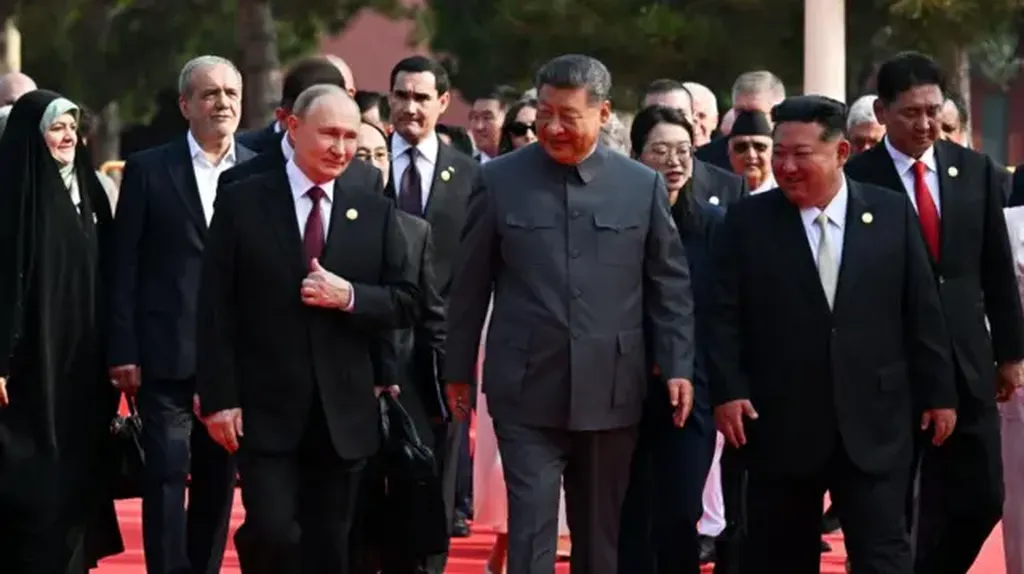China’s Victory Day Parade in Beijing on 3 September showcased an impressive array of military advancements, with Russian President Vladimir Putin and North Korea’s Kim Jong-un standing alongside Chinese Premier Xi Jinping. The display highlighted China’s growing arsenal of laser weapons, nuclear missiles, and cutting-edge drone and defence technologies. Among the most eye-catching elements were robotic wolves—four-legged robots capable of reconnaissance, ammunition transport, and precision strikes—as well as AI-powered aerial drones that can operate alongside manned fighter jets. Perhaps the most striking innovation was the AJX-002, a 60-foot unmanned submarine capable of operating up to 20 metres underwater.
The parade underscored the rapid evolution of drone technology, which is reshaping military doctrine and strategic capabilities. Noah Ramos, a strategist at Alpine Macro, noted that drones operating on land, sea, and air are increasingly able to collaborate with one another and with human operators, shifting the balance of power in conflicts. Ukraine’s success in countering Russia’s military might since the 2022 invasion has been largely attributed to its effective use of drones. Despite being undermanned and under-financed, Ukraine has managed to neutralise Russia’s sophisticated and expensive war machines with a fleet of relatively inexpensive drones, two-fifths of which are domestically produced. Oleksandr Kamyshin, an adviser to Ukrainian President Volodymyr Zelensky, described weapons production as “Ukraine’s oil,” emphasising the country’s innovative approach to warfare.
Loredana Muharremi, an aerospace and defence equity analyst at Morningstar, told *MoneyWeek* that Ukraine’s experience demonstrates the critical importance of “drone parity” in modern warfare. She argued that drone innovation is fast, cost-effective, and decisive in overpowering traditional, complex, and slow systems. The goal for drone manufacturers is not necessarily to create the “best” drone, but the most adaptable and cost-effective. Companies that can innovate quickly, produce cheaply, and deploy rapidly will enjoy lasting competitive advantages, she said.
On the same day as China’s parade, Peter Fortune, the MP for Bromley and Biggin Hill, told a House of Commons debate that “a $300,000 sea drone can destroy fighter jets worth $50bn.” Alistair Carns, the minister for the armed forces, warned that countries like Russia and China are already producing drones on an industrial scale and investing heavily in innovation to make them more capable and deadly, while removing the human presence from the battlefield. Carns described recent advances in drone technology as “a machine-gun moment for the army, a submarine moment for the navy and a jet-engine moment for the air force.”
Despite China’s impressive display, the country is largely playing catch-up to the US, which remains the world leader in drone technology. The Manta Ray, developed by the US Defence Advanced Research Projects Agency (Darpa) and Northrop Grumman, is a long-distance underwater drone that can harvest energy from ocean thermal gradients and enter a low-energy “hibernation” mode if required. Ramos described the Manta Ray as “essentially a surveillance vehicle that has no range limitations and is equipped with an entire suite of incredibly high-tech sensors.” Its ability to avoid detection by not emitting heat signatures makes it particularly formidable.
The latest trends in drone technology mirror developments in the civilian realm, with automation, computer vision, and energy storage playing central roles. Modern drones often feature light detection and ranging (LiDAR) sensors and hyperspectral sensors, giving them 3D vision and making them more effective in contested environments. They also utilise multiple power sources to minimise the risk of a single point of failure, ensuring continued operation even if one system is disabled.
Artificial intelligence and automation are driving the most significant advancements in drone technology. While drones have long been “unmanned,” they are increasingly autonomous, with “swarms” of drones capable of being operated by a single human operator. Remote sensors automatically optimise the distribution of drones within a swarm, adjusting if some are destroyed.
The rapid innovation in drone technology is converging with another key factor: increased defence spending by governments worldwide. In Europe, the war in Ukraine and US President Donald Trump’s calls for greater European defence contributions have unlocked billions of euros in fresh spending commitments. Similar dynamics are evident in the Indo-Pacific region, where HANetf estimates that there will be about $600bn in additional defence spending by 2030, with significant contributions from both mature and fast-growing economies.

